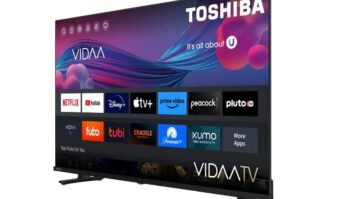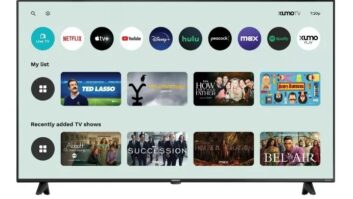NEW YORK – One of the biggest trends among leading- edge TV manufacturers in recent years has been to make TVs “smart” by building in Internet connectivity while providing a host of app-enabled streaming services to turn passive tube watching into an interactive experience.
As the capability takes over most of the upper-tier series models planned for 2013, the industry is seeing divergent positions on how the experience is best delivered — via an all-in-one set or as part of a connected solution that uses a set-top streamer, video game console, Blu-ray Disc player or even a mobile device to deliver the “brains” to the TV screen or monitor.
Despite elaborate smart-TV product launches at International CES this year, evidence that supports the latter approach is resonating with a large segment of the mainstream audience.
“According to our recent consumer research, connected TVs are still not a strong purchase driver in the U.S.,” said Paul Gagnon, NPD DisplaySearch North American TV market research director. “This is reflected in the sell-through as very little or no appreciable growth in the mix of network capable sets over the last year, which is only very slowly showing growth over the last few years.”
The divide in strategies has contributed to the stalled adoption of smart TVs in 2011 and 2012 as so-called “dumb” TVs (those with minimal features) accelerate.
Further evidence is seen in the continued sales of media streamers, such as those offered by Roku, Apple, Western Digital, Boxee, Google and others, with market research firm Informa estimating global set-top streaming device sales to exceed 50 million by 2017, an increase of 500 percent since 2012. These allow consumers to hold onto old TVs or direct their dollars at large screens by sacrificing the integrated features like smart-TV functionality.
Bigger still, is the use of video game consoles to access online movie and music services.
“Right now, especially in the U.S., consumers are so focused on price that they are essentially voting with their wallets to purchase ‘dumb’ TV’s that are large and cheap,” noted Gagnon. “In addition, the centralized hub model is being disrupted by all the power and popularity of mobile devices like tablets and smartphones and the expansion of Cloud-based services that negate the need for an in-home content hub. Devices just need to handle stream decoding and content search/selection.”
Tamaryn Pratt, Quixel Research principal, estimated the share for connected TVs is running about 21 percent of the total market after significant inroads were made in 2008 and 2009.
Despite the sluggishness on the integrated hardware side, streaming services are increasingly popular.
Among those customers highly motivated by smart-TV functionality, movie and music streaming apps remain the most used and motivating drivers at retail, according to Pratt.
Meanwhile, more and more TV makers — particularly among second- and third-tier brands — are adding, AirPlay, Miracast and Mobile High-definition Link (MHL)-enabled HDMI inputs that allow mobile devices to easily hook up to big screens to share streaming audio and video content in the living room, with no extra purchase required.
“It is really about the business model,” said Pratt. “To date, the connected TVs are too difficult for consumers to figure out the benefits they offer. But we are optimistic and expect adoption to increase at least 10 percent in 2013.”
Manufacturers including Sony, Samsung, LG, Vizio and Toshiba have invested in adding more powerful processing while developing the user interface to make smart TV not only easier to use but more personal and compelling.
This year voice and gesture command, facial-recognition systems and tighter integration with mobile devices are appearing in lower price steps, and manufacturers are building in options that let viewers personalize the look, feel and functionality of the interface to each user’s preferences.
“The most important thing in developing a winning smart- TV solution is what does it mean to the consumer and does it give them the opportunity to solve a problem that they have?” said Jay Vandenbree, LG Electronics home entertainment senior VP. “We get asked a lot, ‘Can you define a smart TV?’ That’s like trying to define a computer and what that is. Similarly, nobody’s phone looks alike today, because it’s set up to be a very personal experience.
“That’s much the same way people are telling us they want to operate their smart TVs. What sort of customization do they want? We’re looking to put features in so that they can make the experience theirs, not ours,” Vandenbree continued. “I think that’s where we differentiate ourselves from a lot of our competition. It’s also about how the interface and remote make the system easier to use.”
Some believe Apple will usher in mass acceptance of a smart-TV experience with the rumored launch of an iTV of its own. But the analysts aren’t so sure.
According to Gagnon: “I am still not convinced that Apple is coming with a TV, especially this year … If Apple just launches a fancy TV with similar functionality to the $99 Apple TV settop box, then it will be difficult to convince the masses beyond Apple fanatics to spend a large premium on an Apple product. Even if it carries high-end performance, like 4K resolution or wide-color gamut, it is still essentially similar to offerings from the leading traditional TV brands, who themselves have had difficulty selling large volumes of high-end sets.”
Pratt agreed. “As the prices come down on large-screen TVs, it will be even harder for Apple to compete in a significant way unless they have the content piece ironed out,” she said.
In addition to using smart mobile devices as the conduit to online services and content for connected TVs, a second-screen phenomenon, in which TV audiences engage in social networks and other multifunctional ways with other viewers around a particular program or televised event, is emerging as a potential new path to audience engagement.
For example, the SyFy cable network recently launched a series called “Defiance” that combines the storyline of a TV program with an interactive video game.
“[Second screen] is a very intriguing space, and I can personally attest to how much of an impact it has made in my own home,” said Gagnon. “More richness and greater flexibility to search and control content are only going to help the smart-TV space out. In fact, I think it might evolve to the point where consumers interact with a second screen and use the TV as a well-connected dynamic monitor that can itself connect to all content sources.”
Pratt concurred, saying, “These efforts will put the conversation exactly where TV manufacturers, game creators and content owners need to be. ‘Defiance’ is a huge complex gamble, and it is unlikely that is will single handedly change impressions of connected TV for the bulk of TV viewers because the SyFy channel has a niche audience. However, it could be the wellspring.”
Ultimately, the proliferation of the smart-TV usage and integration of the second screen experience may rely on retailers who can communicate the process to consumers in meaningful ways.
“Demonstration, demonstration, demonstration,” Gagnon said in advising dealers how to spur smart-TV and second-screen adoption. “I am a bit frustrated to see the lack of strong demos of this capability on retail floors, but understand the resource — both human and financial — limitations. Manufacturers need to step up more and help with the messaging and promotion, along with demonstrations, but in our margin- starved industry, it’s a big challenge.”
“Relationships like Best Buy has with Samsung in opening their Samsung Experience Shop are the right moves to cross promote products, explain the features and benefit of the ecosystem,” Pratt offered. “It is almost old-school promotion and education just in a different uniform.”













